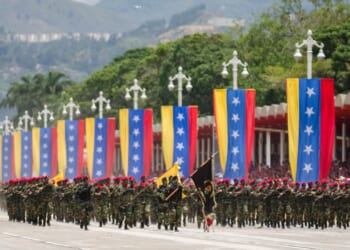If the ARTEMIS, ARES, and ATHENA reconnaissance aircraft were operating near Venezuela, it would likely indicate planning for a future ground invasion of that country.
The United States military’s activity around Venezuela has reached a fever pitch. On top of the US Navy’s and Marine Corps’ presence off the coast of Venezuela, there are now reports that the US Army has deployed their airborne-intelligence, surveillance, and reconnaissance (ISR) prototypes off Venezuela’s coast, too.
Although these reports are unconfirmed, given how many surveillance assets have been deployed to Venezuela in recent weeks, and considering the size of the US force floating off the coast of Venezuela, it should not surprise anyone that the Army might be deploying one variant—or perhaps all three variants—of these newer ISR birds.
Understanding the US Army’s Three Reconnaissance Planes
These Army planes would be conducting critical surveillance missions that will help the American force loitering off Venezuela’s coastline to identify sensitive targets for them to hit once the invasion of Venezuela commences (by all accounts, this conflict is set to go off soon, unless President Donald J. Trump has a last-minute change-of-heart).
There are, in fact, three different US Army ISR prototypes buzzing around the Caribbean right now. They are the Airborne Reconnaissance Targeting Exploitation Mission Intelligence System (ARTEMIS), the Airborne Reconnaissance and Electronic Warfare System (ARES), and the Army Theater-level High-Altitude Expeditionary Next-airborne ISR/Athena-Radar/Athena-SIGINT (ATHENA) systems.
Based on the Bombardier Challenger private jets, these planes have been retrofitted to carry radar, SIGINT, and other sensors to conduct long-range, high-altitude sensing and electronic-warfare work. Previously, the Army has deployed this family of surveillance jets to operational theaters for testing and sensitive missions.
The ARTEMIS is an Army A-ISR Prototype/ATD (initial prototypes of this bird first appeared in 2020) built on a large business jet (the defense contractor Leidos used the Bombardier Challenger 650). It was the first of the Army’s fixed-wing ISR-ATD efforts to demonstrate sensor fusion, targeting, and long-range collection.
The ARES is a later prototype that focused more heavily on SIGINT and electronic warfare as well as ISR. This system was developed by L3Harris/MAG and is based on a Bombardier Global/Global 6500 airframe. It has been deployed to the Indo-Pacific region in years prior.
All three variants of these Army planes have commonalities. For example, they possess large radomes and AESA radars for long-range ground/surface/Maritime surveillance and moving-target indication (MTI). SIGINT suites (COMINT/ELINT) and electronic-warfare payloads for intercepting/geolocating emitters and conducting electronic support measures. Then there is the multi-sensor fusion (combining radar with EO/IR as well as with SIGINT and datalinks—and onboard processing for near-real-time targeting and exploitation.
As for why the Army likes the use of private jet airframes, it has to do with the relatively high transit speed, the long endurance of such airframes for persistent theater coverage while carrying large, upgradeable sensor payloads, and the airframe’s ability to operate at higher altitudes.
A-ISR Planes Near Venezuela Are a Step Toward Invasion
A business jet A-ISR with high-altitude radar and SIGINT could sense farther inland or over maritime approaches than smaller platforms; its SIGINT gear could locate comms or radar emitters and cue other assets.
Because these planes can fly higher and their sensors are strong, they can avoid intruding upon Venezuela’s airspace to glean intelligence from the country by remaining in international airspace adjacent to Venezuela.
The downside, of course, is that these planes are not stealthy. Venezuela’s air defenses could detect, track, and successfully target these planes.
While the presence of these Army planes is not proof-positive that the Trump administration is readying to deploy US forces into Venezuela, it certainly seems like we are on the cusp of such a move. These Army birds are important for war planners to see what it is they and their forces will be tussling with once the shooting begins.
Keep an eye out for the Venezuela situation declining rapidly in the coming days. That these planes (and other similar assets) are present in the skies around Venezuela indicates that a peaceful resolution is not in the offing for this conflict.
About the Author: Brandon J. Weichert
Brandon J. Weichert is a senior national security editor at The National Interest. Recently, Weichert became the host of The National Security Hour on America Outloud News and iHeartRadio, where he discusses national security policy every Wednesday at 8pm Eastern. He is also a contributor at Popular Mechanics and has consulted regularly with various government institutions and private organizations on geopolitical issues. Weichert’s writings have appeared in multiple publications, including The Washington Times, National Review, The American Spectator, MSN, and the Asia Times. His books include Winning Space: How America Remains a Superpower, Biohacked: China’s Race to Control Life, and The Shadow War: Iran’s Quest for Supremacy. His newest book, A Disaster of Our Own Making: How the West Lost Ukraine is available for purchase wherever books are sold. He can be followed via Twitter @WeTheBrandon.
Image: Wikimedia Commons.
















